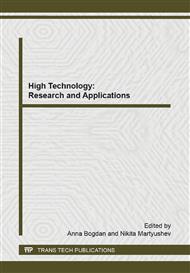[1]
L. Burtseva, A. Pestryakov, and V. Petranovskii, Monosized sphere packing approach in the nanoporous structure modeling, Strategic Technology (IFOST), 2012 7th International Forum on. (2012), 1-6.
DOI: 10.1109/ifost.2012.6357573
Google Scholar
[2]
A. Mayoral, H. Barron, R. Estrada-Salas, A. Vazquez-Duran, and M. Jose-Yacaman, Nanoparticle stability from the nano to the meso interval, Nanoscale, Vol. 2, no. 3, (2010), 335-342.
DOI: 10.1039/b9nr00287a
Google Scholar
[3]
P. Dubov, D. Korolkov, and V. Petranovskii, Klastery i matrichno-izolirovannye klasternye sverkhstruktury, St. Petersburg State University: Izd-vo S. -Peterburgkogo universiteta (1995).
Google Scholar
[4]
G. E. Mueller, Numerically packing spheres in cylinders, Powder Technol., Vol. 159, no. 2, (2005), 105-110.
DOI: 10.1016/j.powtec.2005.06.002
Google Scholar
[5]
C. C. Furnas, Grading Aggregates I-Mathematical Relations for Beds of Broken Solids of Maximum Density, Ind. Eng. Chem., Vol. 23, no. 9, (1931), 1052-1058.
DOI: 10.1021/ie50261a017
Google Scholar
[6]
C. Marchal, Study of the Kepler's conjecture: the problem of the closest packing, Math. Z., Vol. 267, no. 3-4, (2011), 737-765.
DOI: 10.1007/s00209-009-0644-2
Google Scholar
[7]
T. C. Hales, A proof of the Kepler conjecture, Ann. Math., Vol. 165, no. 3, (2005), 1065-1185.
DOI: 10.4007/annals.2005.162.1065
Google Scholar
[8]
R. A. Rankin, The Closest Packing of Spherical Caps in n Dimensions, Glasgow Math. J., Vol. 2, no. 03, (1955), 139-144.
DOI: 10.1017/s2040618500033219
Google Scholar
[9]
C. A. Rogers, The Packing of Equal Spheres, P. Lond. Math. Soc., Vol. 8, no. 4, (1958), 609-620.
Google Scholar
[10]
H. J. H. Brouwers, Particle-size distribution and packing fraction of geometric random packings, Phy. Rev. E., Vol. 74, no. 3, (2006).
DOI: 10.1103/physreve.74.031309
Google Scholar
[11]
K. d. L. Kristiansen, A. Wouterse, and A. Philipse, Simulation of random packing of binary sphere mixtures by mechanical contraction, Physica A: Statistical Mechanics and its Applications, Vol. 358, no. 2–4, (2005), 249-262.
DOI: 10.1016/j.physa.2005.03.057
Google Scholar
[12]
A. Bezrukov, D. Stoyan, and M. Bargieł, Spatial statistics for simulated packings of spheres, Image Anal Stereol, Vol. 20, no. 3, (2001), 203-206.
DOI: 10.5566/ias.v20.p203-206
Google Scholar
[13]
H. N. Lalena, Principles of Inorganic Materials Design: John Wiley & Sons, (2010).
Google Scholar
[14]
S. Jeong, W. Sangbok, S. Kang, and J. Park, A batch splitting heuristic for dynamic job shop scheduling problem, Comput. Ind. Eng., Vol. 33, no. 3-4, (1997), 781-784.
DOI: 10.1016/s0360-8352(97)00252-0
Google Scholar
[15]
M. L. Mansfield, L. Rakesh, and D. A. Tomalia, The random parking of spheres on spheres, J. Chem, Phys, Vol. 105, (1996), 3245-3249.
DOI: 10.1063/1.472166
Google Scholar
[16]
G. Y. Onoda, and E. G. Liniger, Random loose packings of uniform spheres and the dilatancy onset, Phys Rev Lett, Vol. 64, no. 22, (1990), 2727-2730.
DOI: 10.1103/physrevlett.64.2727
Google Scholar
[17]
V. A. Luchnikov, M. L. Gavrilova, N. N. Medvedev, and V. P. Voloshin, The Voronoi–Delaunay approach for the free volume analysis of a packing of balls in a cylindrical container, Future Gener. Comp., Vol. 18, no. 5, (2002), 673-679.
DOI: 10.1016/s0167-739x(02)00032-8
Google Scholar
[18]
M. Bargieł, and J. Mościński, C-language program for the irregular close packing of hard spheres, Comput. Phys. Commun., Vol. 64, no. 1, (1991), 183-192.
DOI: 10.1016/0010-4655(91)90060-x
Google Scholar
[19]
D. He, N. N. Ekere, and L. Cai, Computer simulation of random packing of unequal particles, Phy. Rev. E., Vol. 60, no. 6, (1999), 7098-7104.
DOI: 10.1103/physreve.60.7098
Google Scholar
[20]
A. R. Kansal, S. Torquato, and F. H. Stillinger, Computer generation of dense polydisperse sphere packings, J. Chem. Phys., Vol. 117, no. 18, (2002), 8212-8218.
DOI: 10.1063/1.1511510
Google Scholar
[21]
M. D. Webb, and I. L. Davis, Random particle packing with large particle size variations using reduced-dimension algorithms, Powder Technol., Vol. 167, no. 1, (2006), 10-19.
DOI: 10.1016/j.powtec.2006.06.003
Google Scholar


